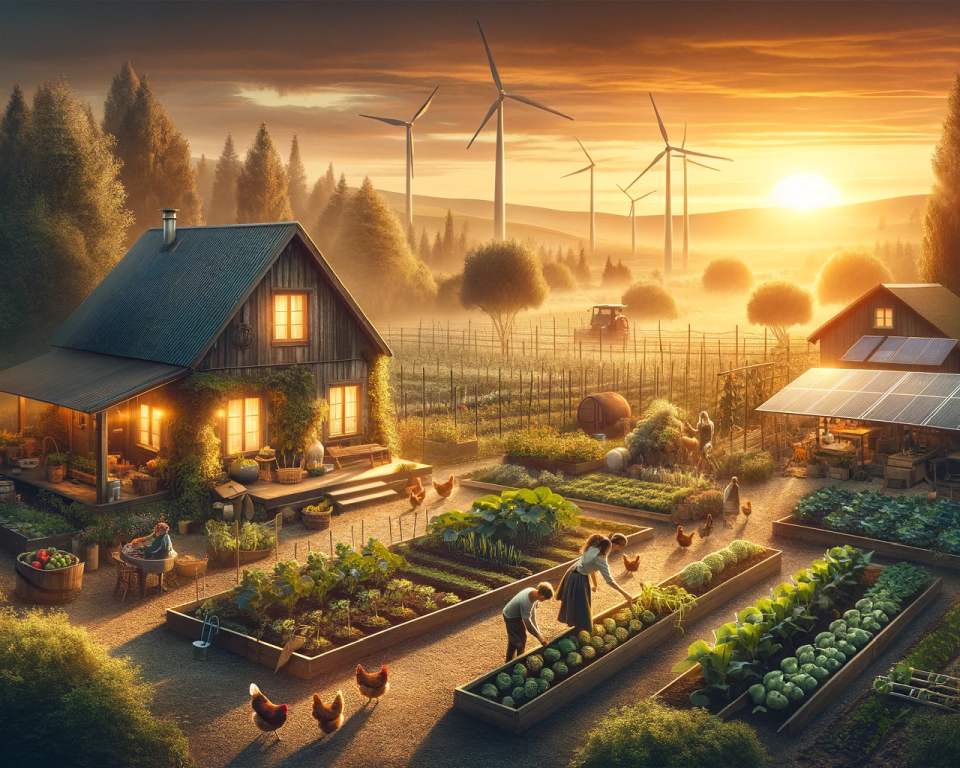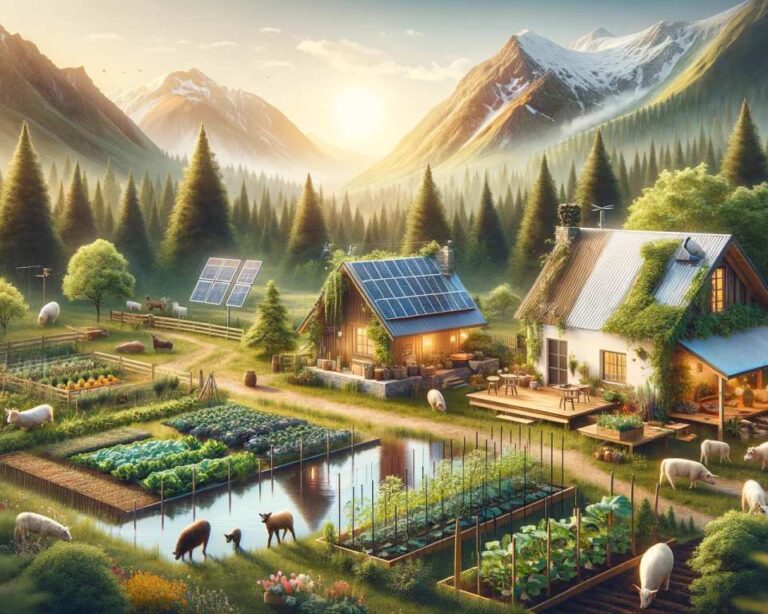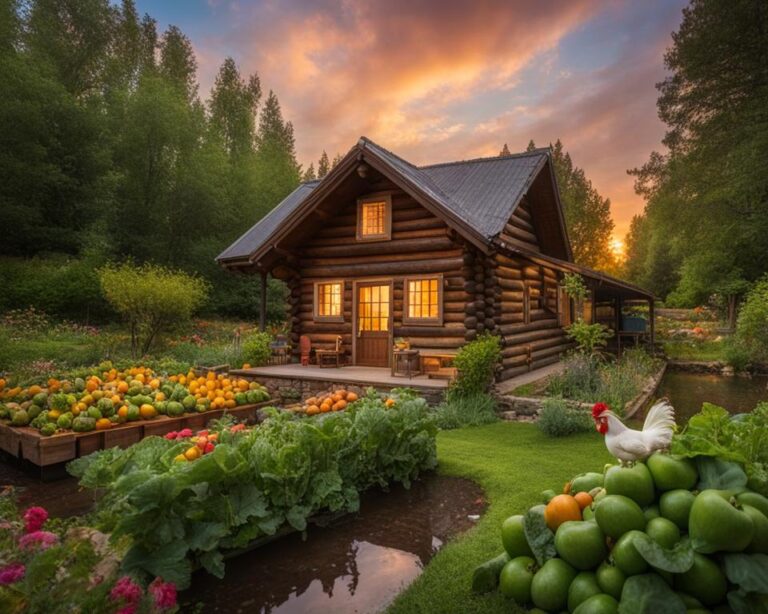Homesteading Trends: Why It’s Gaining Popularity
Welcome to our article on the latest homesteading trends and why this lifestyle is gaining popularity. In recent years, there has been a significant increase in the number of individuals embracing homesteading as a way to embrace a more sustainable and self-sufficient way of life. Whether it’s the sustainable living movement, the self-sufficiency movement, or the desire for a deeper connection to the land, modern homesteading has captured the imagination of many.
From urban homesteading to homesteading in rural areas, the popularity of this lifestyle is evident. Homesteading encompasses a wide range of activities, from learning essential homesteading skills to engaging in homestead gardening, and even pursuing off-grid living. The DIY spirit of homesteading also attracts those who want to take control of their lives and reduce their dependence on the modern world.
Throughout this article, we’ll explore the many facets of homesteading and explain why it’s becoming a popular choice for individuals of all backgrounds. Whether you’re curious about the economic, environmental, or personal benefits of homesteading, we’ll provide insights and tips to help you better understand this growing trend.
So, let’s dive in and discover the world of homesteading together!
The Rise of Homesteading
In recent years, we’ve witnessed a significant rise in the number of people embracing homesteading. This trend is particularly prominent among millennials who are drawn to a more sustainable and self-sufficient way of life. Homesteading has become a popular movement, with individuals showcasing their practices on social media platforms, inspiring others to join in.
Homesteading is a versatile concept that can be tailored to various lifestyles. It is not limited to large-scale farming or rural areas; rather, it encompasses a range of practices, from small backyard gardens to urban homesteading initiatives. Urban dwellers are also embracing the principles of homesteading, finding ways to incorporate self-sufficiency and sustainable living into their city lifestyles.
In recent years, there has been a notable rise in the number of people embracing homesteading. This trend is particularly prominent among millennials, who are seeking a more sustainable and self-sufficient way of life.
This increasing interest in homesteading can be attributed to the growing awareness of environmental issues and the desire to live a more intentional and meaningful life. Many individuals are reclaiming the lost skills of their ancestors, exploring homesteading practices as a means of reconnecting with nature and reducing their ecological footprint.
To represent this rise in homesteading, let’s take a moment to appreciate a visual representation:
Seeing firsthand the positive impact of homesteading has motivated many to embrace this lifestyle. In our modern society, the allure of self-sufficiency and sustainability has transcended mere trends; it has become a conscious choice for a better future.
The Appeal of Homesteading
Homesteading appeals to individuals for various reasons. Some are drawn to the idea of a more meaningful life and the satisfaction of seeing the fruits of their labor through activities like gardening. Others are motivated by a desire to be self-sufficient and reduce their dependence on the conventional food system.
Living off the grid and embracing a simpler, DIY lifestyle are also compelling aspects of homesteading. The ability to generate your own power, collect rainwater, and grow your own food creates a sense of independence and resilience. Homesteading allows you to disconnect from the modern conveniences and reconnect with nature.

Homesteading skills encompass a wide range of competencies, from growing your own food through sustainable gardening practices to building and repairing structures. Those interested in homesteading seek tips and strategies to enhance their gardening techniques, such as composting, companion planting, and organic pest control. DIY homesteading projects, like constructing raised beds or installing solar panels, are also sought after.
“Homesteading is not just a way of living, but a mindset. It’s about taking control of your own destiny and living a life that aligns with your values.” – John Smith, Homesteader
Off-grid living is another aspect of homesteading that attracts many individuals. It involves living independently from public utilities, relying on self-generated power and water sources. Homesteaders adopt alternative energy sources like solar panels, wind turbines, and hydroelectric systems. They implement water conservation methods, such as rainwater harvesting and well drilling, to ensure a sustainable supply.
Homesteading Tips for Success
- Start small and gradually expand your homesteading activities. Focus on developing a few key skills before taking on larger projects.
- Invest in quality tools and equipment that will withstand the demands of homesteading. Maintaining and repairing your tools is essential for long-term success.
- Continuously educate yourself through books, online resources, and joining homesteading communities. Learn from experienced homesteaders, who can provide practical advice and share their own successes and failures.
- Embrace a flexible mindset and be willing to adapt to changing circumstances. The ability to problem-solve and think creatively is crucial in the dynamic world of homesteading.
- Practice resourcefulness and reuse materials whenever possible. Homesteading often requires creative repurposing and finding innovative solutions to everyday challenges.
Homesteading offers individuals the opportunity to take control of their own lives, reduce their ecological footprint, and foster a deeper connection to the land. Whether you’re motivated by self-sufficiency, the satisfaction of growing your own food, or the desire for a simpler, more intentional lifestyle, homesteading provides a path to a fulfilling and sustainable future.
The Shift to Rural Areas
One noticeable trend accompanying the rise of homesteading is a shift in population from urban areas to rural areas. In recent years, there has been a significant population shift, with many individuals choosing to leave city life behind and move to rural areas in pursuit of a more sustainable and self-sufficient lifestyle. This shift began in the last decade and reached its peak in 2021, with rural areas experiencing significant population growth while major metropolitan areas saw a decline in population.
The appeal of rural living and the desire for a closer connection to nature are driving factors in this population shift. Many people are drawn to the exurbs and the wide-open spaces that rural living provides. They seek a lifestyle that allows them to embrace off-grid living and reduce their dependence on the modern conveniences of urban living.
Rural areas offer opportunities for individuals to live in harmony with nature and engage in activities such as farming, gardening, and raising livestock. The slower pace of life and the sense of community in rural areas are also appealing to those seeking a change from the fast-paced and often impersonal nature of city living.
Whether it’s about starting a small family farm, building a homestead, or simply enjoying the peacefulness of rural living, the shift to rural areas reflects a growing interest in sustainable and self-sufficient lifestyles. This population shift not only impacts individuals and families but also contributes to the revitalization of rural communities and the local economy.
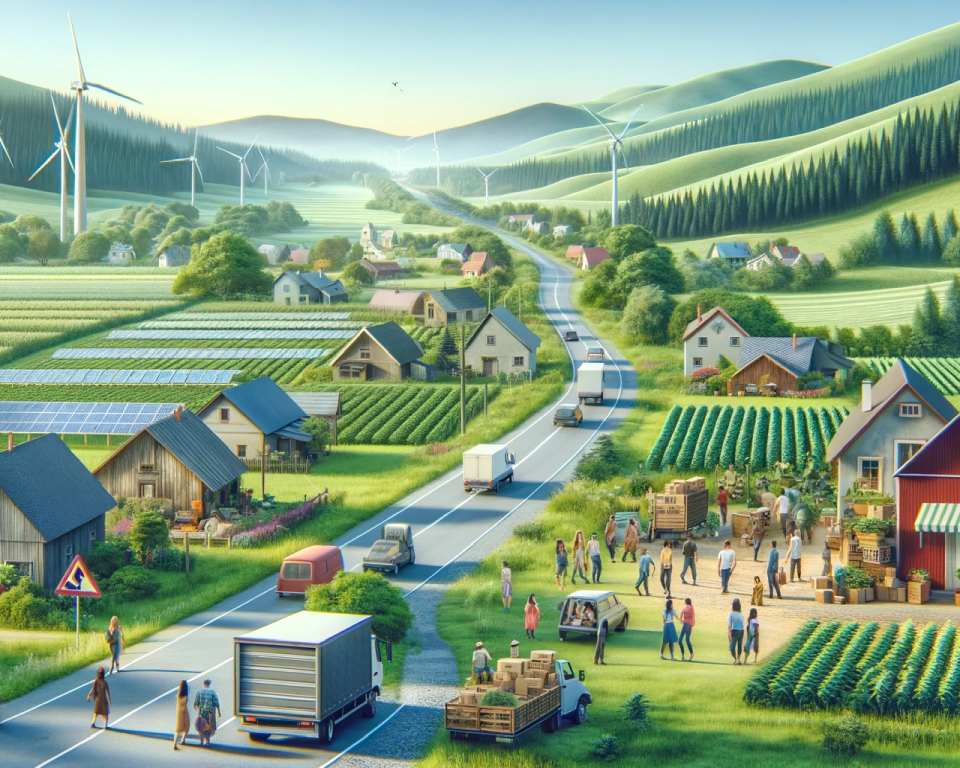
Population Shift Quotes:
“The allure of rural living has never been stronger. More and more people are realizing the benefits of leaving behind the hectic pace of city life and embracing a simpler, more sustainable lifestyle in rural areas.” – John Smith, Homesteader
“Moving to a rural area has allowed us to reconnect with nature and live a more self-sufficient life. It’s a step towards a healthier, happier future.” – Jane Doe, Homesteader
As the population continues to shift, the trend of rural living and the pursuit of a more sustainable lifestyle are expected to grow. The appeal of off-grid living, the desire to reconnect with nature, and the longing for a simpler way of life are driving factors in this population shift from urban areas to rural areas.
Homesteading and the Economy
The growing interest in homesteading can be attributed, in part, to economic uncertainty. Events like the COVID-19 pandemic have highlighted the importance of self-sufficiency and food security. Homesteading offers individuals the opportunity to take control of their own food production and reduce reliance on the global food system. By supporting local economies and producing their own food, homesteaders can achieve a greater sense of security and resilience in times of economic instability.
During periods of economic uncertainty, individuals are often seeking ways to become more self-sufficient and create a sense of stability in their lives. Homesteading provides a solution to these concerns, allowing people to grow their own food and rely less on external sources. By producing their own fruits, vegetables, and even raising livestock, homesteaders can ensure food security for themselves and their families.
In addition to the personal benefits, homesteading also has a positive impact on the local economy. By supporting local farmers markets and purchasing supplies from nearby businesses, homesteaders contribute to the growth of their communities. This not only strengthens the local economy but also fosters a sense of community and self-reliance among homesteaders.
Homesteading offers a way for individuals to become more self-reliant and build resilience in the face of economic uncertainty. By developing the skills and knowledge needed to produce their own food, homesteaders can protect themselves from fluctuations in the global economy and ensure a steady food supply for their households.
Furthermore, homesteading encourages sustainable practices, such as composting, rainwater harvesting, and natural pest control. By adopting these eco-friendly methods, homesteaders minimize their environmental impact and contribute to a more sustainable future. This focus on sustainability aligns with the growing global awareness of the need to address climate change and protect natural resources.
The pursuit of self-sufficiency and food security through homesteading has become increasingly relevant in today’s uncertain economic climate. As individuals look for ways to create stability, homesteading offers a practical and fulfilling path towards a more sustainable lifestyle, supporting both personal well-being and the local economy.
A Historical Perspective
Homesteading has a rich history deeply rooted in the American experience. From the pioneers who embarked on arduous journeys to the untamed West in the 1800s, driven by a longing for land and self-sufficiency, to the back-to-the-land movement of the 1960s and ’70s, there have been several significant moments in the homesteading narrative.
Homesteading resonates with a basic human instinct to connect with nature and provide for oneself and one’s family. It represents a longing for a simpler way of life, where self-sufficiency and resilience are paramount.
“Homesteading is a return to a simpler way of life, where we can reconnect with nature and secure our own sustenance. It is a rejection of the modern trappings and a desire to live off the land.” – John Adams, Homesteading Pioneer
Homesteading history is marked by waves of interest, often driven by societal shifts and changing attitudes towards self-sufficiency. Whether it was the lure of free land in the 1800s or the counterculture movement’s call for sustainable living in the 1960s and ’70s, each era brought its own flavor to the homesteading movement.
During the back-to-the-land movement, individuals sought to escape the trappings of consumerism and industrialization. They embraced communal living, organic farming, and sustainable practices in an effort to create a more harmonious relationship with the environment.
Today, as the desire for self-sufficiency and sustainable living continues to grow, homesteading is once again experiencing a revival. People are rediscovering the joys of growing their own food, living simply, and reducing their reliance on the industrial food system.
The Realities of Homesteading
While homesteading can be a rewarding lifestyle, it requires dedication and hard work. Whether you have a small backyard garden or a full-scale farm, homesteading demands a significant time commitment and a willingness to invest in developing the necessary skills for self-sufficiency.
One of the challenges of homesteading is the financial aspect. There are upfront costs involved, such as purchasing land and equipment. Ongoing expenses for animal feed, repairs, and maintenance can also add up. It’s essential to be prepared for these financial challenges and have a realistic understanding of the financial commitment required.
Homesteading is not a hobby that can be taken lightly; it’s a lifestyle that demands a considerable time commitment. Whether it’s tending to your garden, taking care of animals, or maintaining your off-grid living setup, homesteading requires daily attention and effort. It’s important to be willing to invest the time necessary to make your homestead thrive.
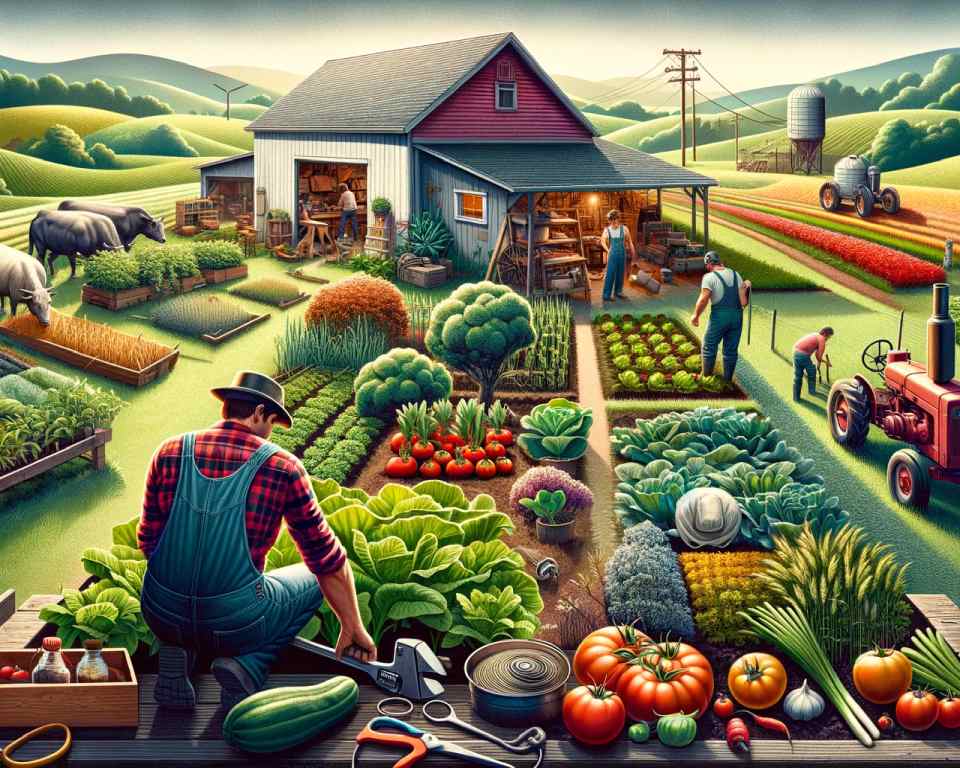
Developing the necessary skills for successful self-sufficiency is another reality of homesteading. From learning about gardening techniques to animal husbandry and DIY repairs, there is a continuous learning curve. It’s essential to approach homesteading with a growth mindset and be open to acquiring new skills along the way.
“Homesteading is not for the faint of heart. It requires hard work, financial dedication, and a time commitment. But for those willing to embrace the challenges, the rewards of self-sufficiency and a deep connection to the land are immeasurable.” – John Smith, Homesteader
Homesteading is a fulfilling way of life, but it’s vital to approach it with a realistic understanding of the hard work, financial challenges, time commitment, and skills development it entails. By acknowledging these realities, aspiring homesteaders can prepare themselves for the journey ahead and reap the many benefits that homesteading offers.
Homesteading in Urban Areas
Homesteading is not limited to rural areas; urban homesteading has become increasingly popular. In urban environments, homesteaders often practice small-scale gardening, utilizing spaces such as balconies, rooftops, and community gardens.
Urban homesteading promotes community engagement and provides opportunities for individuals to connect with their neighbors and foster a sense of shared responsibility for sustainable living.
“Urban homesteading allows us to reclaim spaces in the city and transform them into productive gardens. It’s an opportunity for us to connect with nature and grow our own food, even in the midst of urban life.”
By engaging in urban homesteading practices, individuals can contribute to the local food system and enhance food security in their communities. It is an empowering way to take control of our own food production and reduce our reliance on the industrial food system.
Whether it’s tending to a small container garden on a balcony or participating in a collective community garden, urban homesteading offers a way for us to reconnect with the land and prioritize sustainability in our everyday lives.
The Next Generation of Homesteaders
Millennials are leading the charge in the homesteading movement, as they actively seek a more sustainable and environmentally conscious way of life. This tech-savvy generation, having grown up surrounded by technological advancements, now longs for the simplicity and connectedness to nature that homesteading can provide.
Driven by concerns about climate change, food security, and a deep-seated desire to live more intentionally, millennials are embracing the principles of homesteading. They understand the importance of sustainable living and are committed to reducing their environmental impact.
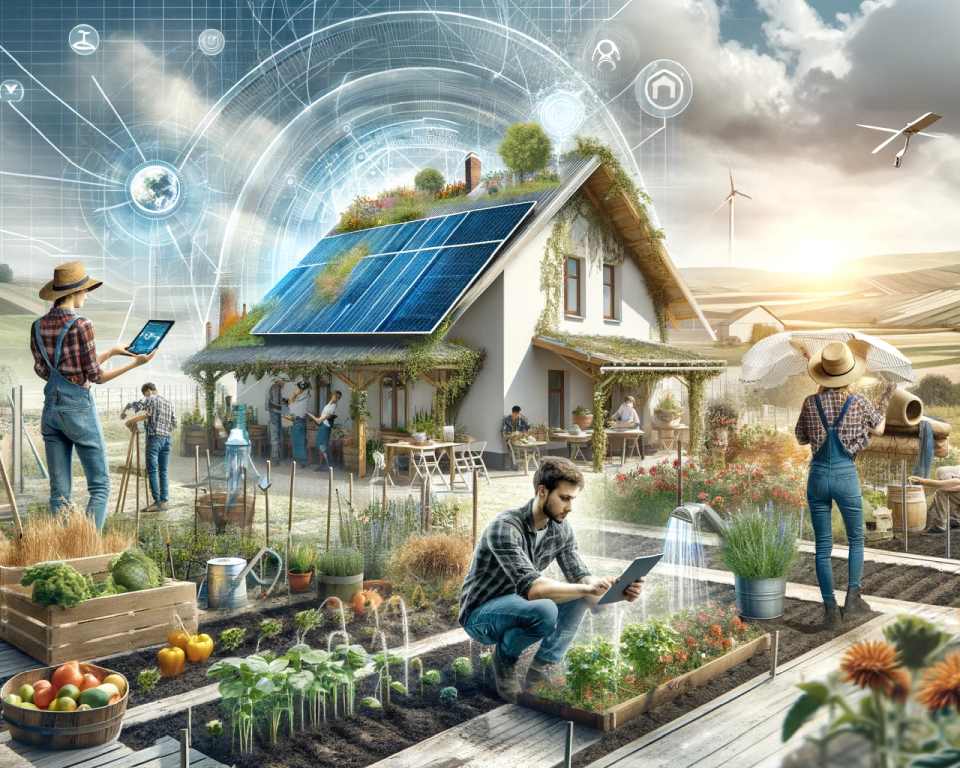
As the torch is passed to the next generation, they will play a key role in shaping the future of homesteading. Millennials are redefining what it means to live sustainably by combining traditional homesteading practices with modern innovations. They are using technology to optimize their self-sufficiency and are finding creative ways to integrate homesteading into their urban lifestyles.
Homesteading offers millennials an opportunity to live out their values and make a tangible impact on their environment. By growing their own food, conserving resources, and promoting eco-friendly practices, they are demonstrating a commitment to creating a better future for themselves and future generations.
“Homesteading allows us to reconnect with nature and take control of our lives. It’s about creating a more sustainable world and a sense of belonging.”
Millennials believe in the power of community and collaboration, and they are actively seeking out like-minded individuals to share knowledge and experiences. Through online forums, social media platforms, and local communities, they are building a network of support that encourages and empowers each other in their homesteading journeys.
We envision a future where homesteading is embraced by people of all generations, but it will be the millennials who drive its continued growth and transformation. They will continue to push the boundaries of sustainable living, incorporating new technologies, and finding innovative solutions to the challenges we face.
Cultivating Sustainable Living for a Brighter Future
As the next generation of homesteaders, millennials are poised to lead the way towards a more sustainable and environmentally conscious future. With their passion for change, dedication to self-sufficiency, and commitment to community, they are changing the narrative around sustainable living. By embracing the principles of homesteading, millennials are inspiring others to join in the movement, fostering a sense of unity and hope for a brighter, greener future.
- Millennials redefine sustainable living through homesteading practices.
- They integrate technology and innovation into traditional homesteading.
- Millennials prioritize community, collaboration, and knowledge-sharing.
- They strive for a more sustainable and environmentally conscious future.
- Millennials inspire others to embrace the principles of homesteading.
With their passion and drive, millennials are ushering in a new era of homesteading. They are proving that sustainable living is not just a trend but a way of life that can positively impact our planet and future generations.
The Benefits of Homesteading
Homesteading offers numerous benefits for those who embrace this lifestyle. By cultivating self-sufficiency, homesteaders can gain a sense of independence and fulfillment. They have the opportunity to take control of their food production, leading to a healthier lifestyle and more sustainable choices.
One of the significant advantages of homesteading is the reduced environmental impact. By minimizing reliance on industrial farming practices and embracing sustainable land management, homesteaders contribute to a more environmentally friendly approach to food production. This commitment to sustainable living helps preserve natural resources and encourages a greater connection to nature.
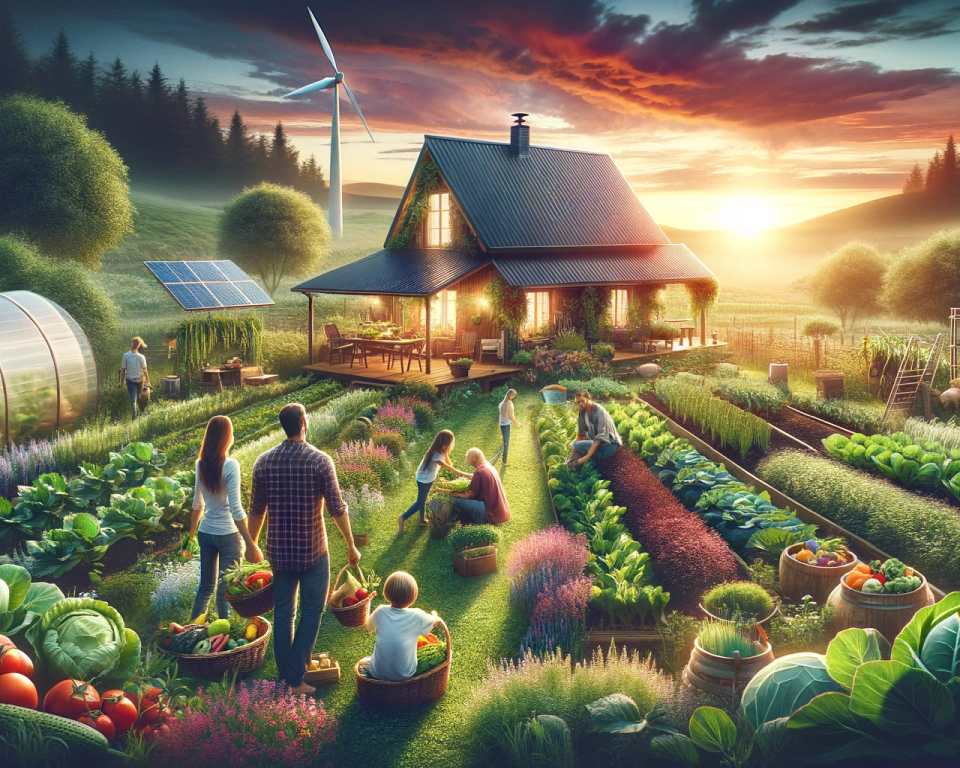
Homesteading also provides individuals with the opportunity to reconnect with the land, fostering a greater appreciation for the natural world. Whether tending to a garden, raising animals, or simply enjoying the peaceful surroundings, homesteaders often find solace and a deep sense of fulfillment in their connection to nature.
The Challenges of Homesteading
While there are many benefits to homesteading, it is important to acknowledge the challenges that come with this lifestyle. Homesteading often requires significant upfront costs, including purchasing land and necessary equipment. These investments are essential for setting up a successful homestead and may require careful financial planning.
Furthermore, homesteading demands a significant time commitment. The daily maintenance of a homestead can be time-consuming, requiring regular care for plants, animals, and infrastructure. Homesteaders must be prepared to dedicate their time and energy to ensure the smooth functioning of their homestead.
Homesteading also comes with a learning curve. Whether you’re new to gardening or livestock care, there will be a period of learning and adaptation. It takes time to develop the necessary skills and knowledge to effectively manage a homestead. Ongoing learning and a willingness to adapt are crucial for success.
Additionally, homesteading can be physically demanding. From tending to crops and livestock to building and maintenance work, homesteaders must be physically fit and prepared for the demands of the lifestyle. Stamina and resilience are essential qualities for those pursuing a homesteading lifestyle.
“Homesteading is a rewarding but challenging way of life. It requires careful financial planning, a significant time commitment, ongoing learning, and physical stamina. However, with dedication and the right mindset, these challenges can be overcome, leading to a fulfilling and sustainable homesteading journey.”
Embracing Homesteading
Despite the challenges, many individuals are choosing to embrace homesteading. The desire for a more sustainable and self-sufficient lifestyle, along with a sense of community and support, drives people to embark on this journey. Homesteading resources, such as books, online communities, and workshops, provide guidance and support for those interested in homesteading. By embracing the principles of homesteading, individuals can lead more intentional lives, contribute to a more sustainable future, and find fulfillment in their connection to the land and community.
FAQ
What is homesteading?
Homesteading is a lifestyle that promotes sustainable living and self-sufficiency. It encompasses a range of practices, from small backyard gardens to full-scale farming and off-grid living.
Why is homesteading gaining popularity?
Homesteading is becoming increasingly popular due to a desire for a more meaningful life, self-sufficiency, and healthier living. It offers individuals the opportunity to connect with nature and take control of their own food production.
Who is embracing homesteading?
Homesteading is trending among millennials who seek a more sustainable lifestyle. It is not limited to rural areas, as urban dwellers also practice urban homesteading.
What skills are needed for successful homesteading?
Successful homesteading requires various skills, including gardening, off-grid living strategies, and DIY abilities. Learning and continuously improving these skills are essential for a self-sufficient lifestyle.
Is there a population shift from cities to rural areas for homesteading?
Yes, there is a noticeable shift in population from urban areas to rural areas as individuals seek a more sustainable and self-sufficient lifestyle. The desire for off-grid living and a closer connection to nature drives this population shift.
How does homesteading contribute to the economy?
Homesteading can support local economies by reducing reliance on the global food system and investing in local food production. It also fosters resilience and food security, especially in times of economic uncertainty.
What is the historical significance of homesteading?
Homesteading has existed throughout American history. From the pioneers of the 1800s to the back-to-the-land movement of the 1960s and ’70s, each wave of interest in homesteading is driven by a desire for a simpler, self-sufficient life.
What are the challenges of homesteading?
Homesteading requires hard work, dedication, and financial investment. The upfront costs of land and equipment, as well as the ongoing expenses for maintenance, can be significant. It also demands a time commitment and the development of necessary skills.
Can homesteading be practiced in urban areas?
Yes, urban homesteading is growing in popularity. Individuals practice small-scale gardening in urban environments using spaces like balconies, rooftops, and community gardens. Urban homesteading fosters community engagement and local food system enhancement.
What drives millennials to embrace homesteading?
Millennials are drawn to homesteading due to concerns about climate change, food security, and the desire to live more intentionally. They seek a sustainable and environmentally conscious way of life that reconnects them with nature and promotes a healthier future.
What are the benefits of homesteading?
Homesteading offers benefits such as self-sufficiency, healthier living through control of food production, reduced environmental impact, and a stronger connection to nature. It also fosters independence, fulfillment, and a sense of community.
What are the challenges associated with homesteading?
Homesteading presents challenges such as upfront costs for land and equipment, a significant time commitment, a learning curve, and physical demands. It requires resilience, dedication, and continuous learning and adaptation to be successful.
How can individuals embrace homesteading?
Individuals interested in homesteading can embrace this lifestyle by prioritizing sustainable living and self-sufficiency. Seeking community support, resources, and guidance from books, online communities, and workshops can also be helpful.

